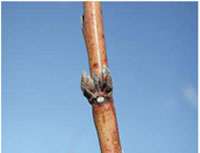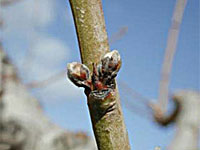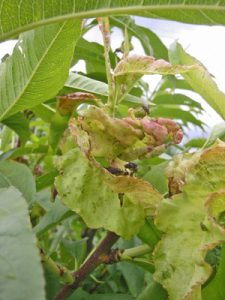Peach Leaf curl is caused by the fungus Taphrina deformans. The spores of the fungus lodge in the bud scales of peach and nectarine trees in the summer, overwintering there until the tree begins to break dormancy. At that time, the new leaf tissues are infected, causing the cells to grow larger than normal, which gives the diseased leaf the characteristic swollen, distorted look. Wet conditions and temperatures from 48° to 70° favor the fungus. Sounds like our typical spring weather, doesn’t it?
- Tight buds, before swelling
- Buds swelling
Now is the time to be monitoring peach and nectarine trees for bud swell. To control peach leaf curl, it is important to treat for the disease just as the bud begin to swell. This can occur anytime from mid-January through early February, depending on temperatures. The last couple of years, bud swell has started in early January. With the warmer than normal winter we’ve had, the peaches at Cloud Mountain are beginning to swell now.
At Cloud Mountain, we use lime-sulfur to control peach leaf curl. Fixed copper products are also effective and much easier for the home owner to buy. Sulfur and copper products don’t kill anything. They act as prophylactic controls, smothering the spores by not allowing sufficient oxygen for the spores to germinate and infect the buds. Take home message: The spray has to be on the tree before temperatures and rain allow an infection! And, a reminder, even organic pesticides are toxic, so always follow label directions!
Why control Peach Leaf Curl? A slight infection probably won’t seriously damage your trees, but severe or repeated infections can. The distorted leaves cannot photosynthesize as well as uninfected leaves, and usually drop early. This reduced leaf surface stresses the tree. Severe infections also distort the new growth and flower buds, reducing fruiting. We don’t always get the timing exactly right, but we get good enough control that our trees are not too stressed by the small amount of leaf curl that they get.
If you have trees of curl resistant varieties, such as Frost, Avalon Pride, Salish Summer, Betty, or Indian Free, you should still control peach leaf curl if the trees are young. Resistant varieties can still get the disease, and are not established enough to tolerate the disease without stress.
Another reminder, wait to prune stone fruit until after bloom. Pruning while dormant can actually bring your trees out of dormancy, which can be detrimental in a frosty spring.





I have a small orchard of apples & Peaches & Pears. My peach trees are already in leaf. Is it too late to apply a copper fungicide for peach leaf Curl? Thanks so much for your informative site 😊
Yes, the spray is only effective when the buds are just swelling. At this stage, just supporting the trees by water, pruning and fertilizer is your best bet.
What kind of lime should I look for? Some are labeled differently.
Thanks
If you are looking for lime to apply to your soil to keep the pH neutral, any agricultural lime or dolomite lime will be fine- follow the directions on the label for amounts to use when spreading. If you are looking for lime-sulfur to use as a spray, it is no longer readily available to the homeowner. You can used micronized copper or copper soap instead, again, follow the directions on the label. For Western WA, it is too late to spray for peach leaf curl- needs to be done as the buds just begin to swell.
Hi, thanks for all the resources on your site very helpful! My peach tree definitely has leaf curl infection but it is early May, is there anything I can do immediately or do I need to wait until next year at bud swell to apply copper spray – January to February? thanks!
Glad we can help! A copper spray won’t do anything at this point since the infection is already there – the spores overwinter on the twigs and bark, so the buds and leaves inside get infected once the buds begin to swell. But you can take some steps right now to reduce the number of spores in the area around the tree to help in the future. Removing infected leaves once the trees are leafed out (as long as you aren’t majorly defoliating it!) and disposing of them (not compost) will help and then making sure your tree is watered and fertilized to bolster its own defenses. If it is a young tree, removing the fruit will also allow the tree to focus its energy elsewhere. And then copper sprays next year – we recommend 3 sprays 3 weeks apart starting in January. As always, make sure to read the label before applying anything!